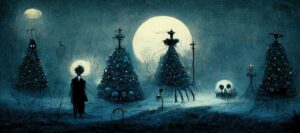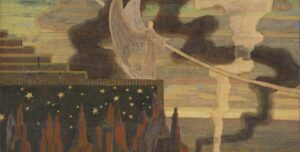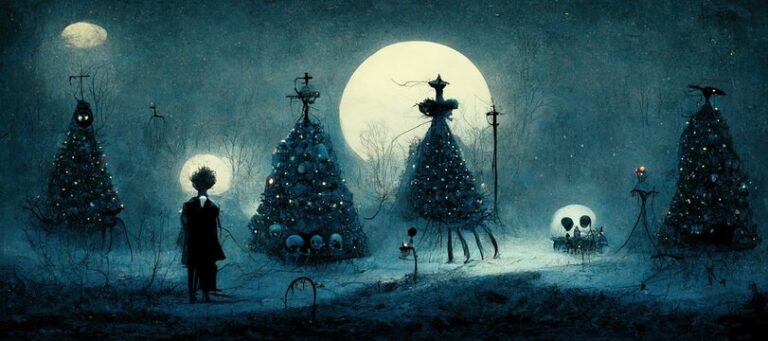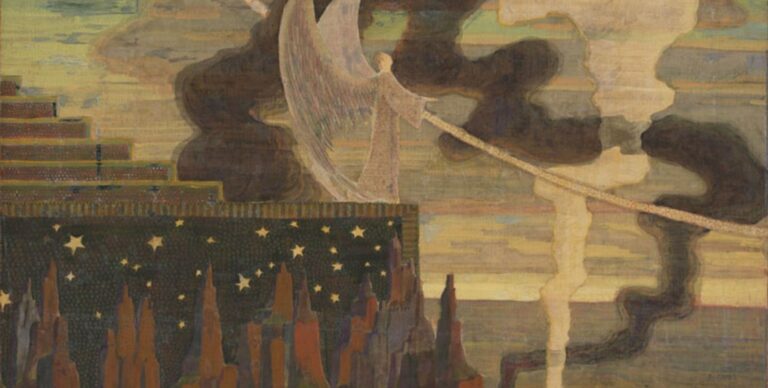This is how this exhibition should have been called and let me be clear about it: I think it’s the best exhibition in town.
Created in collaboration with the Kröller-Müller Museum in Otterlo, Netherlands, it’s curated by Francesco Poli, art historian, Mariella Guzzoni, author of Vincent’s Books, which greatly inspired the exhibition, and Aurora Canepari, curator of the collection of the Oriental Art Museum Edoardo Chiossone in Genoa which lent a significant amount of pieces to this fantastic exhibition.

The exhibition is introduced by a concise biography beautifully illustrated by Alice Alves Esteves de Oliveira.
The rhetoric of Van Gogh as a somewhat simple man shaken by great passions who painted fields and poor people is radically subverted and, by bringing to light the connection between his central themes of choice and his readings, his intellectual enthusiasm is brought to light: from the political writings of Jules Michelet to Charles Blanc‘s colour theory, his books shed a whole new light to his entire production.
« For example, just to name a passion amongst the others, I have a more or less irresistible passion for books and I need to educate myself continuously, to study if you will, exactly like I need to eat my bread. »
The piece that perhaps better encompasses the spirit of this exhibition is Van Gogh’s Still Life with a Chalk Figurine and Books, a revolutionary composition with two of his favourite books being the main characters.
The two books are Guy de Maupassant‘s Bel-Ami, the story of a young social climber, and Germine Lacerteux (1865) by Edmond and Jules de Goncourt, an anti-romantic tale telling the story of a country girl who becomes a nymphomaniac and ends up in an asylum.
But I’m skipping chapters here. Since I don’t want a single piece of this exhibition to go unnoticed, I’ll do my best to give you a complete overview.
1. Michelet and Beecher Stowe: two new Gospels
By the end of 1879, Van Gogh was working as a lay preacher, a job that would force him to confront the role model of his father and to challenge his approach to religion and life. His doubts and his ultimate rejection of the established religious system find confirmation in two books: Jules Michelet‘s History of the French Revolution, and Harriet Beecher Stowe‘s abolitionist work such as Uncle Tom’s Cabin.
« Take Michelet and Beecher Stowe, for instance: they don’t say the Gospel is no more valid, but they help us to understand how it can be applied in our time. »
1.1. Jules Michelet’s History of the French Revolution
French historian born in 1798, Michelet is mostly known for his Histoire of France, a monumental work which he wrote during a span of 30 years. The Histoire de la Révolution française is less rigorous and took less time to finish, but the underlying enthusiasm better brings to light his anti-clericalism and his anti-establishment attitude.
Michelet would lose his position and credibility after Napoleon III’s coup in 1851, but his republican fire was more fervent than ever. During this time, he wrote moral pamphlets including La Femme (1860) and L’Amour (1861).
Van Gogh would use a quote from La Femme underneath a vibrant drawing called Sorrow, representing the 32-year-old pregnant Clasina “Sien” Maria Hoornik with whom he was trying to have a relationship. The quote reads:
Comment se fait-il qu’il y ait sur la terre une femme seule?
(Michelet)
The exhibition pairs these books with some of Van Gogh’s earlier works, particularly The Bearers of the Burden.
1.2. Jules Michelet’s L’Oiseau
Michelet will influence Van Gogh also with another book: L’Oiseau, published in 1856, which brought to life a new naturalistic vein already explored in a booklet called L’Insecte. Michelet was introduced to natural history by his second wife Athénaïs, 28 years younger than he was, but already an accomplished author of natural treaties and memoirs. L’Oiseau is certainly Michelet’s most successful book in this area, not much from a scientific point of view but because it brought out the author’s pantheistic views and used natural observation to bring forward moral and social theories.
Van Gogh had an extensive collection of bird nests, that Michelet compares to the work of crafted architects, and in 1885 sent some pieces to his friend and fellow painted Anthon van Rappard. In the accompanying letter, he quotes Michelet in saying that birds are artists. If he indeed knew the book, he’s sure to have admired Hector Giacomelli‘s illustration for the only edition at the time.
2. Millet’s Biographer
In 1882, Van Gogh came in contact with Alfred Sensier‘s biography of the French painter Jean-François Millet, La vie et l’Oeuvre, published just one year prior, and it all came together. Millet’s attention to the poor and their suffering completed the intellectual dissociation Van Gogh felt earlier on between his work as a preacher and the actual attitude of the Church. The road forward was to paint.
Millet was a melancholy and suffering soul, but he was above all a man with the courage of his convictions; faithful and proud in his religion and his art, he devoted to them all the sweetness of his heart, his repose and even his life, which the harshness of the times made all too short […] His life was that of a wise man, a courageous toiler, a loving father and a devoted friend.
(Sensier)
He would copy many works from Millet, but the Sower would certainly be obsessing him for a long while.
3. Thomas Hood’s poetry
Born in 1799, Thomas Hood was an English poet who wrote regularly for magazines such as Athenaeum and Punch, and was particularly known for his attention to social themes. His 1843 poem “The Sogn of the Shirt” is probably his most famous work: it was written in honour of one Mrs Biddell, a widowed seamstress living in conditions that were very common for people at the time. Hood’s poem denounces not only her living condition but also the industrial system that exploited her, resulting in her inevitable debt and imprisonment.
With fingers weary and worn,
With eyelids heavy and red,
A woman sat, in unwomanly rags,
Plying her needle and thread—
Stitch! stitch! stitch!
In poverty, hunger, and dirt,
And still with a voice of dolorous pitch
She sang the “Song of the Shirt.”“Work! work! work!
While the cock is crowing aloof!
And work—work—work,
Till the stars shine through the roof!
It’s Oh! to be a slave
Along with the barbarous Turk,
Where woman has never a soul to save,
If this is Christian work!“Work—work—work
Till the brain begins to swim;
Work—work—work
Till the eyes are heavy and dim!
Seam, and gusset, and band,
Band, and gusset, and seam,
Till over the buttons I fall asleep,
And sew them on in a dream!“Oh, Men, with Sisters dear!
Oh, Men, with Mothers and Wives!
It is not linen you’re wearing out,
But human creatures’ lives!
Stitch—stitch—stitch,
In poverty, hunger, and dirt,
Sewing at once with a double thread,
A Shroud as well as a Shirt.But why do I talk of Death?
That Phantom of grisly bone,
I hardly fear its terrible shape,
It seems so like my own—
It seems so like my own,
Because of the fasts I keep;
Oh, God! that bread should be so dear,
And flesh and blood so cheap!
“Work—work—work!
My Labour never flags;
And what are its wages? A bed of straw,
A crust of bread—and rags.
That shatter’d roof—and this naked floor—
A table—a broken chair—
And a wall so blank, my shadow I thank
For sometimes falling there!“Work—work—work!
From weary chime to chime,
Work—work—work!
As prisoners work for crime!
Band, and gusset, and seam,
Seam, and gusset, and band,
Till the heart is sick, and the brain benumb’d,
As well as the weary hand.“Work—work—work,
In the dull December light,
And work—work—work,
When the weather is warm and bright—
While underneath the eaves
The brooding swallows cling
As if to show me their sunny backs
And twit me with the spring.
Oh! but to breathe the breath
Of the cowslip and primrose sweet—
With the sky above my head,
And the grass beneath my feet
For only one short hour
To feel as I used to feel,
Before I knew the woes of want
And the walk that costs a meal!Oh! but for one short hour!
A respite however brief!
No blessed leisure for Love or Hope,
But only time for Grief!
A little weeping would ease my heart,
But in their briny bed
My tears must stop, for every drop
Hinders needle and thread!”With fingers weary and worn,
With eyelids heavy and red,
A woman sat in unwomanly rags,
Plying her needle and thread—
Stitch! stitch! stitch!
In poverty, hunger, and dirt,
And still with a voice of dolorous pitch,—
Would that its tone could reach the Rich!—
She sang this “Song of the Shirt!”
Van Gogh possibly came in contact with an edition of Hood’s poems illustrated by Gustav Doré, an artist he greatly admired.
4. Émile Zola, Luke Fildes and Charles Dickens: the realism years
Van Gogh discovered Émile Zola while he was in Amsterdam, and quickly realized he wanted to read every single thing he wrote. He was particularly impressed by L’Assommoir, a serial which started in 1876 and was published as a book in 1877: it’s part of the cycle Les Rougon-Macquart, subtitled Histoire naturelle et sociale d’une famille sous le Second Empire. It’s a bleak picture of alcoholism amongst the poorest Parisian working class, and it was an immediate hit. Up to this day, it’s considered Zola’s masterpiece.
Van Gogh wanted to become an illustrator during these years and was thunderstruck by drawings and sketches he saw in European magazines such as The Graphic. In particular, he wrote extensively about a drawing titled Houseless and Hungry by Luke Fildes.
Charles Dickens was sure to fit into this set of interests: Van Gogh studied his principal illustrators such as John Leech‘s illustrations for Dickens’ Christmas Tales, and Luke Fildes‘ drawings for The Mystery of Edwin Drood.
4.1. Influences on the Style
The exhibition gives us a couple of pieces from this period, alongside a small reproduction of Sorrow. The first one is the famous Woman on Her Deathbed, one of the rare pieces by Van Gogh which directly represents death.
Sien Hoornik modelled herself as the dead woman.
My favourite however has to be The Roots in a Sandy Ground, a watered-down watercolour from 1882.
4.2. Influences on the subjects
A realistic representation of the poorest districts is proposed in these two wonderful pieces, painted while he was in The Hague and trying to work out a relationship with the single mother Sien. They’re both magnificent.
5. Art Theory: Charles Blanc
While he was in Nuenen, Van Gogh studied extensively Charles Blanc‘s Grammaire des Arts du Dessin, a 14-volumes paramount work compiled between 1849 and 1869 while he was director of the École des Beaux-Arts in Paris. Though colour wasn’t considered by Blanc as important as the composition, Van Gogh mostly concentrated on his Rose des Couleurs, which inspired him to use contrasting colours such as red and green.
6. Émile Étienne Guimet and Louis Gonse: enters Japonism
In May 1886, after Van Gogh had been in Paris for just three months, a special number of Paris Ilustré came out and it was destined to change the art scenario of its time: it was titled Le Japon and included a selection of illustrations on art, life and customs of distant Japan.
Louis Gonse Editor-in-Chief of the Gazette des Beaux-Arts, published his L’Art Japonais in 1883: the gorgeous retrospective, with a cover by Camille Martin and lavish illustrations by Henri Charles Guérard, became one of the cornerstones for the growing interest of Parisians towards Japan and its art. Siegfried Bing, who issued a special limited reprinting of this work in 1886, was the most prominent merchant of Japanese art in Paris, and we know Van Gogh could spend entire days in his gallery, looking for prints. He would end up owning more than six hundred of them.
Émile Étienne Guimet was a traveller and a collector, he established a library and a school for Oriental languages in Lyon and was responsible for another book that greatly influenced Van Gogh: Promenades Japonaises, a travel account illustrated by Félix Régamey.
Van Gogh admired Hiroshige, but never mentioned him. He painted two works after his illustrations. They’re mostly considered a parenthesis in the artist’s work, but I simply adore them.
Though never mentioning Hiroshige, he talked about Hokusai way above many other artists. To Van Gogh, Japan was a place for the soul, a dream state flowing from nature to his paintings. It’s hard not to conjecture that this kind of work, in this particular period of his life, made him happy like little others.
7. Japonism and naturalism: Loti’s Madame Chrysanthéme
Van Gogh painted a grand total of fourteen views of orchards while in Arles, and I think this is where the exhibition really comes together at the peak of its beauty. The connection of his naturalistic views with Japonism is drawn through a 1887 novel by Pierre Loti called Madame Chrysanthéme. The story is presented as the autobiographical novel of a naval officer who has an affair with a Japanese woman while stationed in Nagasaki, eventually marrying her for a short while. It was extremely successful and highly influential on the attitude of XX Century Europeans towards Japan and Japanese people. I don’t think I mean this in a good way.
Van Gogh liked the novel enormously, anyway: it was a good bridge between actual Japan and his imaginary Japan, melted together with the countryside of Provence.
«…and isn’t it almost a true religion that these Japanese teach us, so simple and living in nature as if they’re flowers themselves?»
Amongst the essays published in that period, Van Gogh starts to distance himself from Siegfried Bing and his views: he considers his essay on Programme to be “too dry”, and he generally doesn’t feel his contemporaries share his almost mystical sensibilities towards Japan.
8. The illness years: Shakespeare
In the hospital of Saint-Paul-de-Mausole, Van Gogh returns to familiar readings and goes back to Dickens, Beecher Stowe, and Shakespeare. To him, the Bard is like Rembrandt:
« Who’s as mysterious as he is? His word, his ways are like a brush quivering with fever and emotions. »
His favourite tragedies to read are Richardo II, Henry IV, Henry V and Henry VI. They upset him, though, King Lear in particular, and this is what he confesses to his sister Wil:
« When I have finished reading, I always find myself compelled to go look at a blade of grass, a pine branch, an ear of corn to calm myself down. »
The most touching painting of this period has to be Pine Trees at Sunset, painted in December 1889 during really bad weather: he decides to retouch it and soften the colours with strokes of green, so that his sister won’t have to see too much evidence of his illness.
My favourite, however, has to be The Ravine: same period, same bad weather, but an untamably wild subject.
9. Back to the Gospel: Olive Groves
Whenever he would walk outside the hospital walls, Van Gogh would find himself surrounded by olive groves and the environment brought him back to evangelical subjects, particularly the ordeal of Christ in the Getsemani garden. Van Gogh doesn’t like similar scenes painted either by his contemporaries and his predecessors: the only viable exception is Rembrandt:
« …he doesn’t do anything similar to the other religious painters: he’s permeated with metaphysical magic. »
Van Gogh had an incision by Rembrandt hanging on his bedroom walls back in 1878, when he was studying to become a preacher, and he brings it back while he’s endeavouring to paint not Christ but just the groves.
Van Gogh dies in July 1890, not long after having painted a grand total of 15 olive trees and groves.


































2 Comments
Pingback:Theatre: the Architecture of Wonder – Shelidon
Posted at 14:25h, 13 December[…] utterly magical. It positions itself as one of the best exhibitions to be seen in Milan, alongside Van Gogh and Rodin. It’s an exhibition to be walked and re-walked, to be taken in body and soul, and […]
Pingback:Munch’s Inner Scream – Shelidon
Posted at 17:05h, 14 November[…] a discovery that shouldn’t come as a surprise and we already saw was the leitmotiv of the splendid exhibition around Van Gogh and his books. Over his long life, he managed to create thousands of prints and paintings, filled page after page […]